|
Roti CD |
Troubled Grass and Crying Bamboo: The Music of Roti
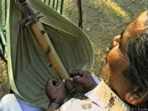
|
|
| San Malelak |
The island of Roti is located just southwest of West Timor in the semi-arid tropics of Roti and Lombok. The recording Troubled Grass and Crying Bamboo: The Music of Roti features examples of the two main musical genres in Roti, poetic song accompanied by sasandu tube zither, and the meko gong and drum ensemble. It also features a soundscape collage of natural and man-made sounds from Roti, including the sounds of morning, a circle dance, night, a story-teller, the sea, and the sasando biola, an expanded, diatonic form of the sasandu.
The title "Troubled Grass and Crying Bamboo" (Falu fik no soda ok) is a translation of a couplet from a Rotinese poetic narrative that describes the origins of death and of song. In this tale, Death claims its first victim, and the bereaved take up the sasandu and sway like the troubled tall grass, their mournful song like the crying voices of the wind in a bamboo grove. This tale is but one example of the way Rotinese use oration, whether recited, chanted or sung, to express, enliven and maintain Rotinese culture.
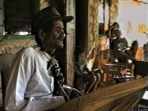
|
|
| Daniel Huan |
At the heart of all ritual and traditional life in Roti is oration. Traditional oration in Roti finds its most sophisticated expression in a ritual, poetic form of Rotinese that employs parallelism. Ritual, poetic languages in parallel form are found throughout Roti and Lombok (as well as in many other areas throughout the world). These language forms express and encode social wisdom and ritual knowledge which portray reality as fundamentally dualistic, in a syntactic form that is itself dyadic. For example, the Rotinese couplet Hata hori au masik, oe dae ana noe ("Man is like salt, touched by water he dissolves") metaphorically expresses the dualistic nature of the human condition - which seems solid and enduring although it is fragile and ultimately ephemeral - within the guidelines of Rotinese grammatical parallelism.
Most Rotinese songs alternate verses in parallel language with a refrain in standard Rotinese or Bahasa Kupang, the regional lingua franca comprised of Malay, Dutch, Rotinese and Timorese elements. While each song is identifiable by its distinctive refrain, the verses are variable and singers may use the same parallel couplets in many different songs. The overall mood of many traditional Rotinese songs is one of gentle melancholy; the theme - that life is full of suffering, governed by fate, and ultimately illusory.
The main accompanying instrument for Rotinese song is the sasandu, a plucked, bamboo tube-zither with a palm leaf resonator. Its ten or eleven strings are usually made from strands of motorcycle coupling wire, and their pitch is adjusted with individual, movable bridges and tuning pegs. The resonator is made by shaping the large fan-leaf of the lontar palm into a pleated hemisphere. Although it resembles tube-zithers found among other Austronesian peoples (for example, the Savunese ketadu haba, the Sikkanese santo, and the Malagasy valiha) the Rotinese claim the sasandu as their own invention, and revere it as the single most distinctive medium and symbol of their music culture.
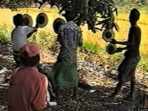
|
|
| Busalanga Iron Meko Group |
Besides sasandu-accompanied song, the other main musical genre in Roti is the meko group, an ensemble of nine (or sometimes ten) either locally made iron or imported bronze, bossed gongs, and a labu drum. Usually played to accompany dance, meko group compositions are comprised of interlocking parts that may repeat indefinitely, played at uniform tempo and maximum volume. With its brash and bold style, the sound of the meko group provides a sharp contrast to the relatively quiet and introspective sasandu.
Rotinese musical performances happen at festivals and at parties for a birth, the dedication of a new house, a wedding, or a wake. The main music-making tends to go on in the cool of the night, as guests converse, play cards, drink sweet, strong black coffee, and eat treats like boiled water buffalo hide with sea salt. Many guests also enjoy chewing betel and areca, and some will drink potent, home-made palm gin. Meko gong pieces may be played spontaneously throughout the evening, and typically start when one player picks up a pair of meko and beats out the pattern to a well-known composition. He is joined one by one by other meko players, and finally by the counter-rhythm of the labu drummer. Depending on the piece performed, a few women or men may get up and dance the appropriate steps, making the party even more lively. If there is someone present who can sing and play sasandu, he will certainly be urged to perform sometime during the evening (although meko and sasandu share some common repertoire, they never play together). Others present may join in singing the second half of couplets that they recognize, while someone sitting next to the sasandu player will invariably accompany him by drumming on the hard leaf shell of the instrument with a light stick. A talented sasandu-player and singer will improvise verses based on traditional couplets that suit the mood of the occasion, and can sometimes move listeners to tears with his sung poetry.
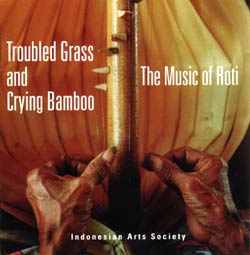
|
Troubled Grass and Crying Bamboo: The Music of Roti (61:16)
- Batu Matia A.A. Malelak, Esau Nalle and Johannes Ledoh 5:29
- Tele Non Tele Ote Ote Non A.A. Malelak and Friends 6:23
- Mudipapa Busalanga Iron Meko Group 3:07
- Tae Benu Busalanga Iron Meko Group 2:05
- Baku Natia Daniel Huan 11:44
- Feto Bo'i Daniel Huan 5:49
- Tae Benu Busalanga Bronze Meko Group 2:44
- Do Ke Ka Busalanga Bronze Meko Group 2:32
- Teo Renda Bernadus and Alexander Henuk 5:13
- Ofalanga Bernadus and Alexander Henuk 4:14
- Rotinese Soundscape 9:25
a. Dawn
b. Circle Dance led by Jonas Moi
c. Night
d. Troubled Grass and Crying Bamboo told by Johannes Mesak
e. Sea
f. Bo Lele Bo sasando biola solo by Eli Koamesa - Batu Matia Henrik Pande, Benyamin Adu and Nikolas Messah 1:51
Includes a 24-page booklet with notes, Rotinese song texts, translations, and 14 colour photos. Recordings, production, notes, translations and photos by Christopher Basile.
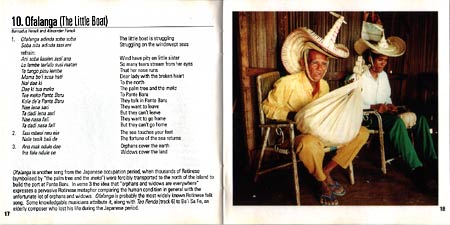
The album Troubled Grass and Crying Bamboo: The Music of Roti was produced in collaboration with the performers and profits from CD sales are shared equally between the producer and the artists. Please read more about how and why this recording was produced.
Purchase this CD.
Read reviews of this CD.
Listen to mp3 audio excerpts from this CD.
Look at photos of the performers on this CD.
Listen to a soundscape from Roti.